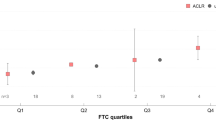Abstract
Background
More than 2 years after undergoing anterior cruciate ligament (ACL) reconstruction, women still present bilateral asymmetries during multijoint movement tasks. Given the well-known ACL-injury gender bias, the goal of this study was to investigate whether males also present such asymmetries more than 2 years after undergoing ACL reconstruction.
Methods
This study involved 12 participants submitted to ACL reconstruction in the ACL group and 17 healthy participants in the control group. The mean postoperative period was 37 months. The participants executed bilateral countermovement jumps and load squat tasks. The kinematics and ground reaction forces on each lower limb and pelvis were recorded, and used to compute bilateral peak vertical ground reaction forces, peak knee and hip joint powers in the sagittal plane, and the ratio between these powers.
Results
For the jump task, the groups had the same performance in the jump height, but for the ACL group the peak knee joint power on the operated side was 13% lower than on the non-operated side (p = 0.02). For the squat task, the hip-knee joint power ratio on the operated side of the ACL group was 31% greater than on the non-operated side (p = 0.02).
Conclusions
The ACL group presented a deficit in the operated knee that had its energy generation over time (joint power) partially substituted by the hip joint power of the same side. The fact that, even after more than 2 years following the ACL reconstruction and returning to regular activity, the ACL group still had neuromuscular asymmetries suggests a need for improvement in the ACL reconstruction surgery procedures and/or rehabilitation protocols.


Similar content being viewed by others
References
Prodromos CC, Han Y, Rogowski J, Joyce B, Shi K. A meta-analysis of the incidence of anterior cruciate ligament tears as a function of gender, sport, and a knee injury-reduction regimen. Arthroscopy 2007;23:1320–5 e6.
Novak PJ, Bach BR Jr, Hager CA. Clinical and functional outcome of anterior cruciate ligament reconstruction in the recreational athlete over the age of 35. Am J Knee Surg. 1996;9:111–6.
Rudroff T. Functional capability is enhanced with semitendinosus than patellar tendon ACL repair. Med Sci Sports Exerc. 2003;35:1486–92.
Colby SM, Hintermeister RA, Torry MR, Steadman JR. Lower limb stability with ACL impairment. J Orthop Sports Phys Ther. 1999;29:444–51 (discussion 52–4).
Shelbourne KD, Klotz C. What I have learned about the ACL: utilizing a progressive rehabilitation scheme to achieve total knee symmetry after anterior cruciate ligament reconstruction. J Orthop Sci. 2006;11:318–25.
Paterno MV, Ford KR, Myer GD, Heyl R, Hewett TE. Limb asymmetries in landing and jumping 2 years following anterior cruciate ligament reconstruction. Clin J Sport Med. 2007;17:258–62.
Shelbourne KD, Gray T, Haro M. Incidence of subsequent injury to either knee within 5 years after anterior cruciate ligament reconstruction with patellar tendon autograft. Am J Sports Med. 2009;37:246–51.
Ernst GP, Saliba E, Diduch DR, Hurwitz SR, Ball DW. Lower extremity compensations following anterior cruciate ligament reconstruction. Phys Ther. 2000;80:251–60.
Neitzel JA, Kernozek TW, Davies GJ. Loading response following anterior cruciate ligament reconstruction during the parallel squat exercise. Clin Biomech (Bristol, Avon). 2002;17:551–4.
Decker MJ, Torry MR, Noonan TJ, Riviere A, Sterett WI. Landing adaptations after ACL reconstruction. Med Sci Sports Exerc. 2002;34:1408–13.
Acknowledgments
This work was in part supported by FAPESP/Brazil grants to M. Duarte (08/10461-7) and to R. Castanharo (07/06810-3) and by CAPES/Brazil to B. Luz.
Conflict of interest
The authors declare that there is no conflict of interest related to this article.
Author information
Authors and Affiliations
Corresponding author
About this article
Cite this article
Castanharo, R., da Luz, B.S., Bitar, A.C. et al. Males still have limb asymmetries in multijoint movement tasks more than 2 years following anterior cruciate ligament reconstruction. J Orthop Sci 16, 531–535 (2011). https://doi.org/10.1007/s00776-011-0118-3
Received:
Accepted:
Published:
Issue Date:
DOI: https://doi.org/10.1007/s00776-011-0118-3




